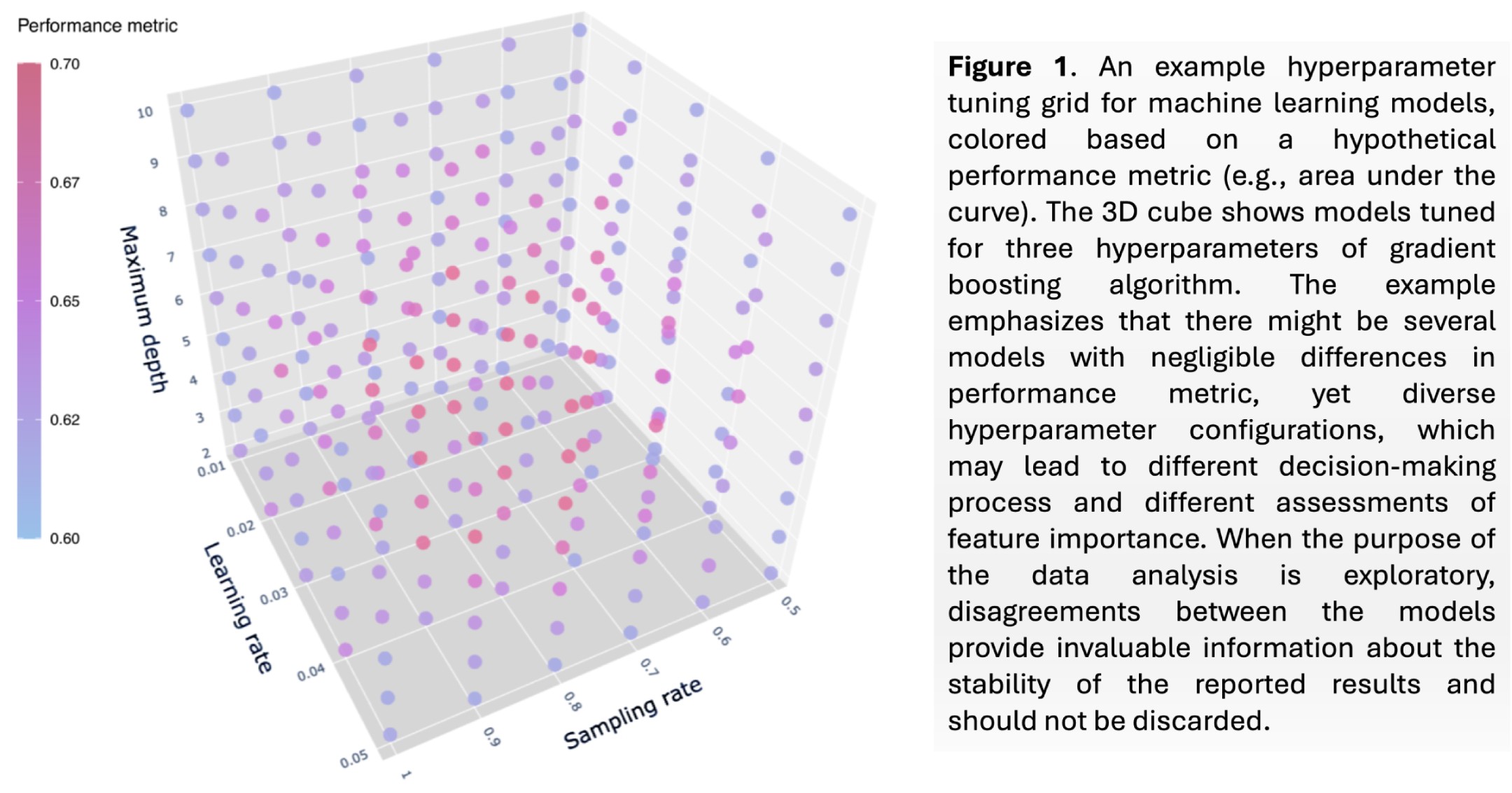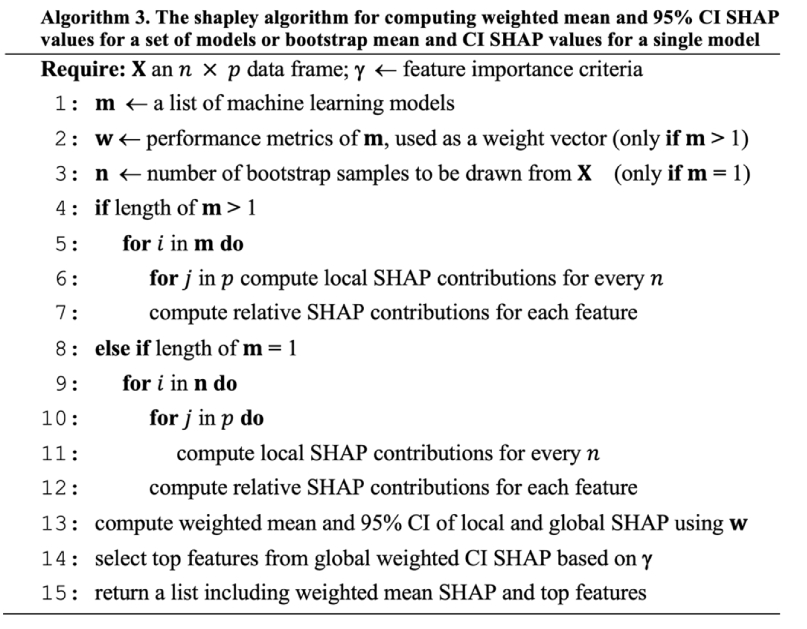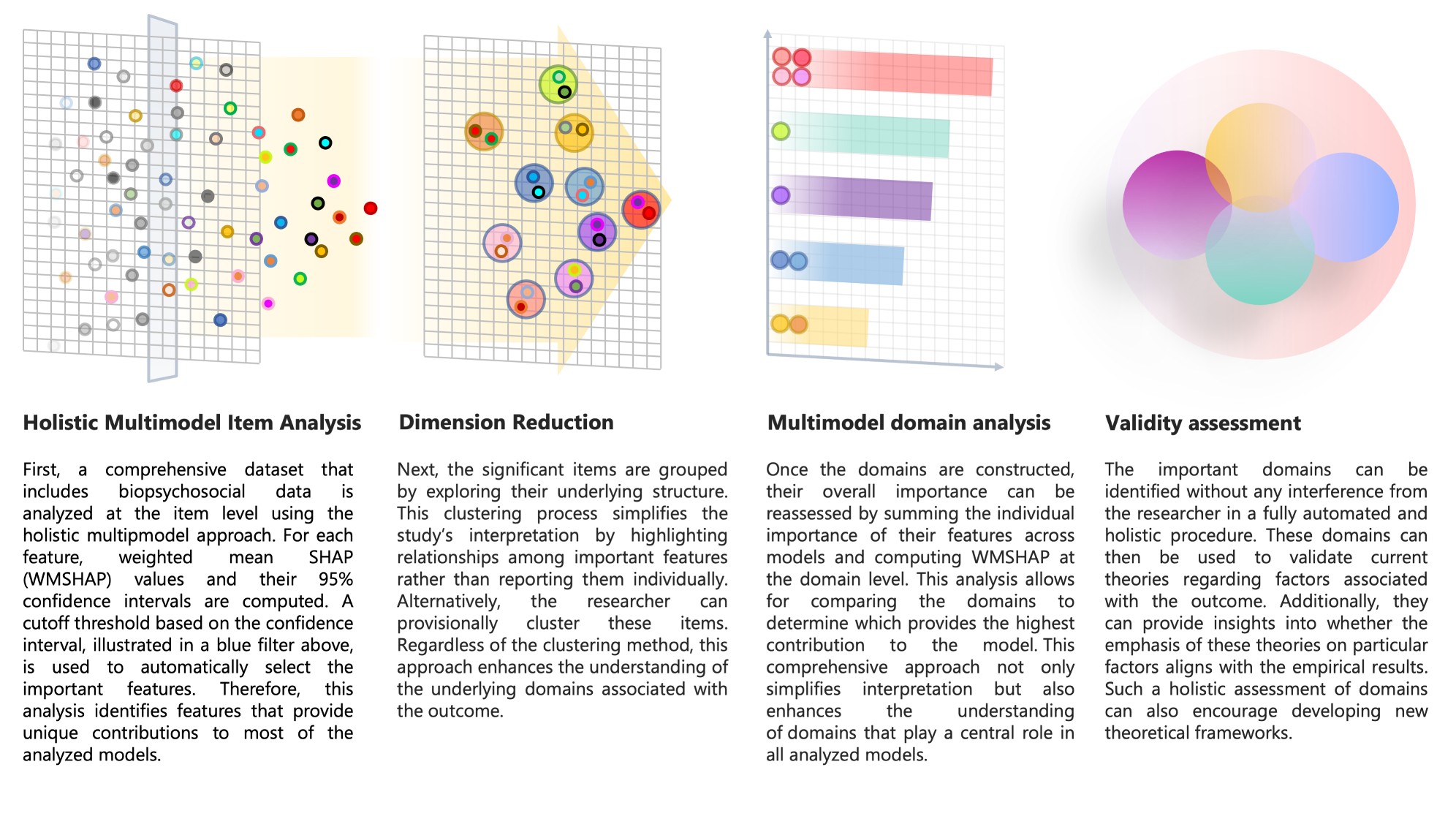Cite: Haghish, E.F. (2025). Enhancing Transparency
and Robustness in Mental Health Research with Holistic Multimodel Domain
Analysis: A Machine Learning Tutorial with a Case Study on
Differentiating Adolescent Suicidal Ideation from Attempt. http://dx.doi.org/10.13140/RG.2.2.32473.63846

Holistic
Multimodel Domain Analysis (HMDA) — A New Paradigm for
Exploratory Machine Learning
Holistic Multimodel Domain Analysis (HMDA) is a new paradigm for
exploratory machine learning research, with notable potential
applications in mental health and well-being research. Traditional ML
analyses typically focus on finding a single “best” model based on
performance metrics such as accuracy or the area under the curve (AUC).
While this approach can be effective for certain predictive tasks, it
can also mask important disagreements among other high-performing
models, and overlook the broader, more nuanced associations that might
exist in a dataset. In exploratory research, such disagreements are
important and should be taken into consideration, rather than making a
single-minded inference regarding the “best” model with a negligible
performance difference.
HMDA overcomes these limitations by integrating results across
multiple strong models—rather than discarding them—thereby offering a
more holistic view of feature importance, domain contributions,
and model interpretability. This document introduces the conceptual
foundations of HMDA, its relation to current challenges in mental health
research, and a practical tutorial on applying HMDA using
R statistical software.
Table of Contents
- Background and
Rationale
- Key Concepts in HMDA
- When to Use HMDA
- Installation
- Tutorial: Applying HMDA in
Adolescent Suicide Research
- Discussion and
Limitations
- Conclusion
- References
Background and Rationale
Machine Learning in
Mental Health Research
Machine learning methods are increasingly used in health research to
classify or predict outcomes. Compared to many traditional statistical
methods, ML approaches offer some advantages (e.g., impose fewer
assumptions, handle a variety of feature types regardless of their
distributions, and can benefit from a large number of features
simultaniously). Despite these advantages, standard ML practices often
focus on identifying a single “best” mode, based on one
performance metric. This procedure becomes inefficient,
especially when the purpose of the research is exploratory, aiming to
reflect on important indicators, rather than making a classification or
a prediction. When the purpose is exploratory, what is desired
is robustness of the findings, their stability, reproducibility, and
replicability. If ML is used to reflect on important domains or
indicators related to a particular outcome, it is important to be able
ensure what is reported as “important” is actually reliable and to do
so, we need an understanding of disagreements between ML models,
rather than solely reporting opinions obtained from the “best”
model.
Consider the following 3-dimensional hypertuning space, which trains
machine learning models for three hyperparameters. You can see that in
such a grid, there will be multiple models with very close performance,
yet, very different hyperparameters, which are not necessarily located
in the same neighborhood. Diversity of the hyperparameters also hints
that the logic of the resulting model can be very different from other
models and hence, such models may have different opinions about the
importance of features in the training dataset.

There are many occasions where the traditional paradigm in ML can be
problematic:
- Model Selection Under Class Imbalance
Mental health research commonly deals with outcomes that have low
prevalence in the population. Low-prevalence outcomes (e.g., suicidal
behavior) introduce severe class imbalance, which complicates the
process of model training, model evaluation, choice of performance
metrics, and even model selection Healy
(2021), Hasanin et al. (2020). This
is a serious problem that has been neglected in machine learning
applications in health research.
- Differences in Performance Metrics
Different performance metrics can yield conflicting assessments,
suggesting different “best” models, and none serve as a universal gold
standard for highly skewed datasets Jeni et
al. (2013). In other words, in real-world scenarios dealt with in
health research, it is not very easy to provide an objective and
gold-standard performance metrics for characterizing the “best” model.
For instance, in binary classification models under severe class
imbalance, the best model is not solely a mathematical problem, but also
an economical one, requiring cost-benefit assessment.
- Disagreements in Feature Importance
Strong models with negligible performance differences or “best” models
selected based on different performance metrics may differ considerably
in which features they regard as most influential to the
models’ decisions. Users who rely on a single model risk overlooking key
covariates that slightly lower-performing models might identify Haghish et al. (2023). Such
disagreements are key to understanding the reliability, robustness,
stability, and generalizability of the findings in exploratory health
research.
Holistic Multimodel
Domain Analysis (HMDA)
Holistic Multimodel Domain Analysis addresses these issues by
combining judgements of multiple high-performing ML models to produce
more reliable, interpretable, and holistic insights about the
underlying data. Rather than ignore models that score marginally lower
on a single performance metric, HMDA weights and aggregates their
feature-importance calculations. This ensemble-like framework not only
reveals which features consistently matter across models but also
highlights areas of disagreement that warrant deeper exploration.
Key Concepts in HMDA
Multiple Model Integration
Instead of discarding all but the “best” model, HMDA consolidates a set
of candidate models that meet a predefined performance
threshold.
Weighted Mean SHAP (WMSHAP)
SHapley Additive exPlanations (SHAP)
estimate each feature’s marginal contribution. HMDA uses shapley refines
SHAP by weighting each model’s feature-importance scores by the model’s
predictive performance (e.g., accuracy, AUC). This generates confidence
intervals around ensemble-level importance estimates.
The WMSHAP values are computed with the shapley
algorithm:

Domain Analysis
HMDA allows researchers to group conceptually related variables into
“domains” (factors or groups of factors). Summing SHAP contributions
within these domains can identify broader patterns and highlight the
most crucial theoretical constructs.
Cross-Model Stability
HMDA’s 95% confidence intervals reflect between-model variability.
Features with wide intervals may be less stable across models—even if
each model individually appears strong—whereas features with narrower
intervals demonstrate consistent influence across models.
Holistic Validity Checking
By incorporating many features from diverse domains (e.g., biological,
psychological, social), HMDA can facilitate discussion about whether
existing theories accurately capture mental health constructs, or
whether additional “neglected” domains might be relevant. The figure
below summarizes that how HMDA may be able to throw some light on
conceptual and theoretical debates by taking multiple domains into
consideration, making no preselection of variables in the data, and
assessing the importance of different domains relative to one
another.

When to Use HMDA
Exploratory Studies
HMDA excels when the primary objective is to discover which variables
and domains are relevant to a mental health outcome, especially if no
strong prior hypothesis about the data structure exists.
Low-Prevalence Outcomes
Ideal for scenarios like suicide risk estimation, where class imbalance
is severe and standard evaluation metrics can be misleading. In this
scenario, using HMDA is rather necessary to avoid bias in exploratory ML
research. Otherwise, researchers risk reporting “arbitrary” important
features, where an alternative model with equal relevance
disagrees.
Cross-Sample Comparisons
If multiple datasets from different populations are available, HMDA can
compare feature-importance rankings and domain-level contributions
across cultural or demographic contexts Mayerhofer et al. (2025). This is a
unique benefit of HDMA and requires a careful hyperparameter tuning to
make the models trained on two different samples to be somehow
comparable (see the Journal Article of HMDA for detailed discussions on
this matter)
Theory Refinement
HMDA provides insight into whether a theory’s proposed risk/protective
domains are empirically supported or overshadowed by other neglected
factors.
Installation
To begin using HMDA in R, install the required packages:
# Install the 'shapley' package from CRAN
install.packages("shapley")
# Install the HMDA package directly from GitHub
devtools::install_github("haghish/HMDA")
Tutorial:
Applying HMDA in Adolescent Suicide Research
Data Preparation
this section uses a real-world data to address theoretical
debates about the progression from suicidal ideation toward suicidal
behavior. Currently, I am awaiting the permission to share the data and
will update the results accordingly.
The following code: - Starts the H2O cluster locally. - Loads an
example dataset provided within the HMDA package. - Identifies
ideation_suicide as the outcome variable. - Splits the data into 80%
training and 20% testing sets with balanced classes.
NOTE: THE DATA IS STILL NOT SHARED WITH HMDA R PACKAGE AND THIS EXAMPLE IS NOT EXECUTABLE.
HOWEVER, THE CODE CAN PROVIDE YOU AN INDICATION IN YOUR RESEARCH. THIS DOCUMENT WILL BE
UPDATED SOON...
library(HMDA)
library(shapley)
# 1) Initiate the H2O machine learning cluster
hmda.init()
# 2) Load the dataset from the HMDA R package
df <- get("ideation_suicide", envir = asNamespace("HMDA"))
# 3) Define outcome (y) and predictors (x)
y <- "ideation_suicide"
x <- setdiff(names(df), y)
# 4) Partition data into training and testing sets
splt <- hmda.partition(
df = df,
y = "ideation_suicide",
train = 0.80,
test = 0.20,
seed = 2025
)
Hyperparameter Tuning
In this example, I use gradient boosting machines (GBM), which
involve parameters like ntrees, max_depth,
min_rows, sample_rate, and
col_sample_rate_per_tree. The hmda.grid() function
systematically trains a grid of models across a range of hyperparameter
combinations. This code defines a list of hyperparameters (params),
launches an grid search for tuning the GBM models, and stores each
trained model along with its performance metrics in the working
directory under "./recovery". If the training crashes,
you’d be able to reload the models and continue from the point the
training crashed.
params <- list(
ntrees = seq(30, 90, by = 5),
max_depth = c(5, 7, 9, 11),
min_rows = c(10, 15, 30, 50, 100),
sample_rate = c(1.0, 0.9, 0.8, 0.7),
col_sample_rate_per_tree = c(0.4, 0.7)
)
grid <- hmda.grid(
algorithm = "gbm",
x = x,
y = y,
hyper_params = params,
training_frame = splt$hmda.train.hex,
stopping_metric = "auc",
stopping_tolerance = 0.001,
balance_classes = TRUE,
recovery_dir = "./recovery"
)
Weighted Mean SHAP (WMSHAP)
After training a large set of models, the next step is to compute
Weighted Mean SHAP (WMSHAP) values. Suppose we only include models with
an AUC > 0.50 (i.e., non-random classification), which is the
default. We can calculate ensemble-level feature importance as
follows:
wmshap <- shapley(
models = grid,
newdata = splt$hmda.test.hex,
plot = FALSE,
performance_metric = "auc"
)
This function filters the model grid based on the specified
performance threshold (default is >0.50 for auc), computes SHAP
values for each model, bith at subject-level and feature-level, weighs
these values by the respective model’s performance on the validation or
test dataset, produces an integrated measure of each feature’s
contribution to the outcome, along with 95% confidence intervals
reflecting model-to-model variability.
Domain-Level Analysis
TO BE CONTINUED…
Discussion and Limitations
Strengths of HMDA
- Enhanced Reproducibility
Traditional ML workflows often produce different sets of “top
features” each time hyperparameters or random seeds are changed. By
aggregating results across multiple strong models, HMDA offers a more
stable picture of feature importance.
- Holistic Perspective
Mental health phenomena like suicidal behavior involve multiple
biopsychosocial factors that interact in complex ways. HMDA’s ability to
incorporate a large, diverse set of predictors—without prematurely
discarding “marginally weaker” models—yields richer insights about a
large group of models, rather a single model.
- Confidence Intervals for Importance
Standard SHAP explains a single model’s behavior without indicating
how representative those feature contributions are across other
plausible models. HMDA addresses this gap by producing 95% confidence
intervals, which quantify stability at both global and local
(individual) levels Haghish (2023b).
Conclusion
If the intention of the study is to explore indicators related to the
outcome of interests, rather than making a prediction that is meant to
be used immediately, then HMDA provides a strong advantage by reflecting
on the robustness of the resuls. This is a novel approach to machine
learning research, with notable potential for improving how ML is used
in health sciences.
References
- Healy, T. (2021). Class Imbalance in Mental Health Research. Journal
of Imbalanced Data, 12(3), 45–61.
- Hasanin, T., Khoshgoftaar, T. M., & Buarque, F. (2020).
Detecting minority classes in imbalanced mental health datasets. Expert
Systems, 37(2), e12494.
- Jeni, L. A., Cohn, J. F., & De La Torre, F. (2013). Facing
imbalanced data – recommendations for the use of performance metrics.
IEEE International Conference on Automatic Face & Gesture
Recognition.
- Haghish, E. F., Obaidi, M., & Smith, R. (2023). Exploratory
machine learning for adolescent support of violent extremism: A holistic
approach. Behavior & Society, 22(4), 321–339.
- Lundberg, S. M., & Lee, S. I. (2017). A unified approach to
interpreting model predictions. Advances in Neural Information
Processing Systems, 30, 4765–4774.
- Peng, R. D., & Hicks, S. C. (2021). Failing better: The
reproducibility crisis and statistical modeling. American Statistician,
75(2), 121–135.
- H2O.ai. (2023). h2o: R Interface for the H2O Scalable Machine
Learning Platform. https://github.com/h2oai/h2o-3
- Breiman, L. (1996). Bagging predictors. Machine Learning, 24(2),
123–140.
- Borsboom, D., Mellenbergh, G. J., & Van Heerden, J. (2004). The
concept of validity. Psychological Review, 111(4), 1061–1071.
- Haghish, E. F. (2023b). shapley: Weighted Mean SHAP for Ensemble
Models. https://github.com/haghish/shapley
- Haghish, E. F., Bang Nes, R., & Kopperud, K. (2023). Agent-based
and dynamic system models in mental health research. Simulation &
Society, 12(3), 210–229.
- Mayerhofer, B., Johansen, R., & Kvaløy, K. (2025). Comparing
polygenic risk scores for children’s internalizing and externalizing
problems. Nature Child Health, 11(2), 78–95.
(Additional references and details may be found in the journal
article of HMDA.)



